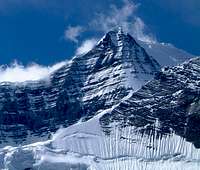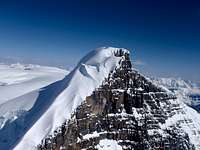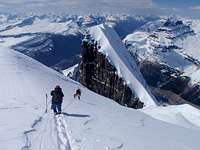-
 21703 Hits
21703 Hits
-
 88.19% Score
88.19% Score
-
 26 Votes
26 Votes
|
|
Mountain/Rock |
|---|---|
|
|
52.22383°N / 117.43386°W |
|
|
Mountaineering |
|
|
Spring |
|
|
12238 ft / 3730 m |
|
|
Overview
North Twin, the mighty giant of the northern Columbia Icefield, is the third highest mountain in the Canadian Rockies at 3730m (12,237 ft.) and highest entirely in Alberta and Jasper National Park. North Twin, and its nearby twin, South Twin (3580m, 11,745 ft.), dominate the skyline of the northern edge of this immense icefield. North Twin is only exceeded in height by the almighty Mount Robson (3954m, 12,972 ft.) and the glorious Mount Columbia (3747m, 12,293 ft.).North Twin and South Twin, The Twins, were named by pioneer mountaineer Norman Collie in 1898 after his and Hermann Woolley’s first ascent of Mount Athabasca. From the summit of Athabasca the two grazed across the horizon, across the immense Columbia Icefield, likely the first people ever to view this icefield; to its northern end to two nearly symmetrical summits, joined by a snowy col. Collie's description of the view from the summit of Mt. Athabasca is classic Canadian Rockies literature.
“The view that lay before us in the evening light was one that does not often fall to the lot of modern mountaineers. A new world was spread at our feet; to the westward stretched a vast ice-field probably never before seen by human eye, and surrounded by entirely unknown, un-named, and unclimbed peaks. From its vast expanse of snows, the Saskatchewan Glacier takes its rise, and it also supplies the headwaters of the Athabasca; while far away to the west, bending over in those unknown valleys glowing with evening light, the level snows stretched, to finally melt and flow down more than one channel into the Columbia River, and thence to the Pacific Ocean."
North Twin was first ascended in 1923 by guide Conan Kain and clients Monroe Thorington and William Ladd, with a long approach via horse back from Lake Louise, and on foot from a camp near Thompson Pass, near Mount Bryce. After the long glacier slog, the team ascended the low angle South East slope, 27 kilometres from camp to summit; they returned the same way, all in one push.
The Twins moniker was originally applied in 1898 for the two highest summits of North Twin and South Twin. Twins Tower was officially adopted as a name in mid 1900’s for the striking tower north of North Twin. “West Twin” is an unofficial name for the highpoint just west of South Twin. Today, many local mountaineers associate the name, The Twins, with these four 11,000 foot plus summits. Some might also include the unofficial, local name of “Son of Twin” (GR 692867) a prominent 3270m (10,728ft.) high point outlier on the North West ridge of Twins Tower, but this obscure summit has likely only ever seen one ascent.
Getting There
North Twin is usually approached from the Icefield Parkway (Banff-Jasper Highway (Highway 93)). From Calgary drive west 165 km on the Trans-Canada Highway to Lake Louise in Banff National Park. From Canmore drive west 81 km to Lake Louise. From Lake Louise drive west 3 km on the Trans-Canada Highway to the Banff/Jasper Highway 93, drive north 125 km to “Columbia Icefield Discovery Centre” and the toe of the Athabasca Glacier.Red Tape / Camping and Bivouacs
All national parks in Canada require an entrance fee. No permit or fee is required to climb in Jasper National Park. A voluntary safety registration system is available for climbers in the Rocky Mountain National parks. It is necessary to register in person at the park information centres or warden offices during business hours. On completion of the excursion, the party must notify the park by telephone or by returning the registration form.Up to date information about climbing and mountaineering in the Rocky Mountain National parks available at:
Rocky Mountain National parks | Climbing and Mountaineering
During the ski season, up to date avalanche bulletins for Rocky Mountain National parks available at:
Avalanche Bulletin - Jasper National Park
Avalanche Bulletin - Banff, Yoho and Kootenay National Parks
Climbers are permitted to bivouac on long routes or otherwise where necessary to safely complete a climb. Some restrictions apply; mostly prohibiting the most popular peaks. A backcountry use permit is required for any overnight stay, contact any Jasper National Park visitor centre, where you may obtain the permit. Most parties will bivy or camp near the North Twin/Stutfield Peak col and ascend North Twin and Twins Tower, then South Twin and “West Twin”, the following day.
Approach
Most straightforward and most used approach to North Twin is from the Athabasca Glacier. From the toe of the glacier parking area, or if the short access road is closed (not ploughed in the winter), from the highway side parking lot, ski towards the toe of the Athabasca Glacier.At the toe of the Athabasca Glacier head up the right side (northern edge) towards a ramp that provides access to the Columbia Icefield, the ramp base is about 5 km from the toe.
Once on the Columbia Icefield the southern edge of Snow Dome must be circumnavigated; generally stay south of the big and obvious crevasses on the south east slopes of Snow Dome, heading west, then angling north, north-west. The Columbia Icefield is not flat, and a serious of glacier hills and valleys are traversed as you head north to your objective.
Generally to ascend any of the The Twins (North Twin, South Twin, Twins Tower or “West Twin”) the base camp should established as close as possible to The Twins/Stutfield Peak Col, about 52.223, -117.408.
From The Twins/Stutfield Peak Col, about 52.223, -117.408 head west, North Twin and its broad South and South-East slopes are very accessible from the col, Twins Tower is usually ascended from North Twin, South Twin and “West Twin” require a traverse south of North Twin to reach their standard routes.
When to Climb
Typical Canadian Rockies situation; best conditions for a ski approach and ski ascent is usually from January to May (earlier means less snow of course), and with July to September usually providing the best conditions for high elevation summer climbing (later usually means less snow of course). Most parties ski/climb North Twin in May on the standard route.Route Descriptions
North Twin has essentially one established route. The line of the first ascent (South Ridge, 1930) was closer to the South Twin/North Twin col, but this same line is used if climbing North Twin after South Twin (recommended). Often parties only ascent North Twin and approach the lower slopes from main Columbia Icefield and ascend the broad South-East slopes. The south and east aspect are fairly low angle and many easy lines are available, some with more crevasse danger than others.Often the incredibly sheer and stunning North Face of Twins Tower is identified as belonging to North Twin, but is directly below the officially named summit of Twins Tower. In 1983 Dave Cheesmond and Tim Friesen, intending to climb the North Face of Twins Tower, traversed off because of difficult conditions and harsh weather; they continued up to the icy North Face of North Twin to the North Twin summit. Dave Cheesmond’s goal was the second ascent of the North Face of Twins Tower and his disappointment was evident as he described this ascent as, “the traverse of the chickens” and never provided a detailed route description or rating.
Canadian climbing and skiing legend Chic Scott has authored many ski mountaineering guide books that provide great information regarding the Columbia Icefield and North Twin. Chic’s guidebook, Summits & Icefields 1 | Alpine Ski Tours in the Canadian Rockies, was recently updated and provides the best information regarding North Twin.
Local mountaineer and writer Bill Corbett has an excellent guidebook describing the standard routes up all Canadian Rockies 11,000’ers, 11,000’ers of the Canadian Rockies
- South Ridge/South-East Ridge, Alpine I
The line of the first ascent, the first winter ascent, and the standard contemporary normal route. Most parties will camp near The Twins/Stutfield Peak Col, 52.223, -117.408 and ascend the South-East Ridge, if climbing North Twin after South Twin, the South Ridge would be ascended.
These low angled ridges provides quick and easy access to the summit ridge. The summit ridge usually has rolling cornices that are typically well anchored on top of the broad ridge, often a party can ski to the summit. Descend the same way, usually on poor snow, but sometimes with great powder.
External Links \ Reference
Summits & Icefields 1 | Alpine Ski Tours in the Canadian Rockies11,000’ers of the Canadian Rockies






















GMJ - Mar 29, 2020 11:56 am - Voted 10/10
Map has vanishedBeautiful page, but the "Twins area map" has vanished.
Old School WB - May 5, 2020 9:31 pm - Hasn't voted
Re: Map has vanishedyes, vanishing map part of my dislike of the upgrade to SP. The last big upgrade caused many of my maps, and some custom topo maps I put a lot of work into, to disappear. If I recall correct, the new web site will not read GIF images. I am not doing back to update all my maps. I will probably just delete all the maps the website will not read anymore. Cheers.